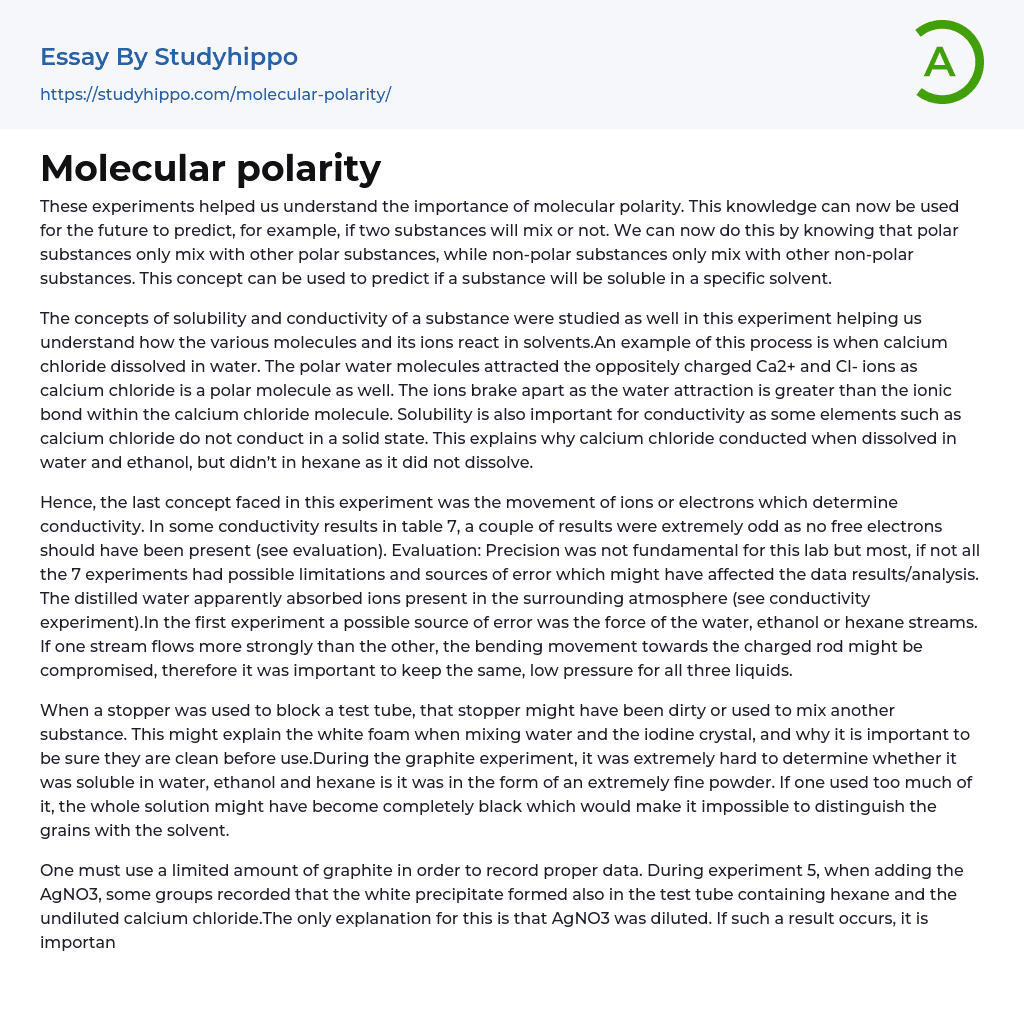Our experiments have yielded insights into the importance of molecular polarity, which can be utilized to anticipate the compatibility between two substances. We have discovered that polar compounds will solely blend with other polar substances, and non-polar compounds will exclusively mix with non-polar counterparts. Henceforth, this principle is instrumental in assessing a substance's solubility within a specific solvent.
The behavior of molecules and ions in solvents was studied in an experiment exploring the relationship between solubility and conductivity. Calcium chloride was used as an example, showing how its polar nature causes attraction between its oppositely charged Ca2+ and Cl- ions with polar water molecules. This attraction breaks apart the ionic bond within calcium chloride due to stronger water attraction. Conductivity is also affected by solubility, as demonstrated by substances such as calcium chloride which
...cannot conduct when solid but can do so when mixed with water or ethanol because they dissolve in these solvents. However, non-dissolving substances like hexane make calcium chloride non-conductive.
Hence, the final concept addressed in the experiment was conductivity, which is determined by the movement of ions or electrons. Table 7 contains conductivity results, however, some results were peculiar as there should not have been any free electrons present (see evaluation). The lab did not require precision, but possible limitations and sources of error affected data results and analysis for all seven experiments. The distilled water absorbed ions from the surrounding atmosphere (see conductivity experiment). The force of the water, ethanol, or hexane streams was a potential source of error for the first experiment. If one stream flowed more strongly than the others, the bending movement towards the charged rod could be compromised
Thus, it was essential to maintain a consistent low pressure for all three liquids.
Using a dirty or previously used stopper to block a test tube could result in the appearance of white foam when mixing water and iodine crystals. Ensuring the stopper is clean before use is therefore important. The experiment with graphite proved challenging as it was difficult to determine its solubility in water, ethanol, and hexane due to its very fine powder form. Adding too much of it could turn the entire solution black, making it impossible to distinguish the grains from the solvent.
Proper data recording requires limited graphite usage. In experiment 5, some groups observed the formation of white precipitate in the test tube containing hexane and undiluted calcium chloride when adding AgNO3. This occurrence can only be explained by the dilution of AgNO3. If such a result arises, it is crucial to comprehend its chemical implications since it is inevitable. Experiment 7 yielded the most distorted outcomes.
It is crucial to test a conductivity tester with a known conductive substance to avoid potential error sources such as dirt or dead batteries. The tray used for testing had very small and closely spaced holes, causing some solutions to mix and compromise their conductivity. To avoid this issue, it is recommended to be careful when pouring solutions and to consider using a pipette.
The conductivity of a solution may have been affected by dirty metal receptors on the conductivity tester. Experiment 7 demonstrated that water-based solutions conducted, such as when mixed with iodine and graphite. This is chemically impossible since neither pure water nor iodine and graphite are soluble conductors. Only calcium chloride with water
and calcium chloride with ethanol should have conducted as calcium chloride does not conduct in its solid state but does when diluted in a liquid state. To ensure accurate results, it is vital to isolate distilled water from possible atmospheric absorption to maintain the presence of ions responsible for conductivity.
- Organic Chemistry essays
- Acid essays
- Calcium essays
- Chemical Bond essays
- Chemical Reaction essays
- Chromatography essays
- Ethanol essays
- Hydrogen essays
- Periodic Table essays
- Titration essays
- Chemical reactions essays
- Osmosis essays
- Carbohydrate essays
- Carbon essays
- Ph essays
- Diffusion essays
- Copper essays
- Salt essays
- Concentration essays
- Sodium essays
- Distillation essays
- Amylase essays
- Magnesium essays
- Acid Rain essays
- Bottled Water essays
- Agriculture essays
- Albert einstein essays
- Animals essays
- Archaeology essays
- Bear essays
- Biology essays
- Birds essays
- Butterfly essays
- Cat essays
- Charles Darwin essays
- Chemistry essays
- Dinosaur essays
- Discovery essays
- Dolphin essays
- Elephant essays
- Eli Whitney essays
- Environmental Science essays
- Evolution essays
- Fish essays
- Genetics essays
- Horse essays
- Human Evolution essays
- Isaac Newton essays
- Journal essays
- Linguistics essays




